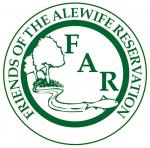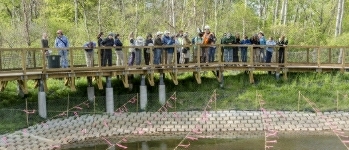From David Brown, Wildlife Assessor:
Seven were on our trip to view the reservation in its major reduced state.. Several observations were made in the course of the pre-walk by me and the walk with FAR participants. The density of deer and coyote tracks on the North Trail testifies to the compression of the wildlife population into a habitat half the size of the pre-destruction. Indeed, during the pre-walk I spotted two coyotes near the construction site that, hemmed in by the fence, were obliged to reveal themselves as they trotted toward the phragmites stand. Normally they would have slipped off unobserved into the silver maple forest. As I discussed with the group, the sudden destruction of the forest is unaccountable in the experience of wild animals and they are probably in some confusion about what has happened and how to rearrange their circumstances. The coyotes that have been squeezed into the North Trail corridor are scratch-scenting heavily as they seek to redefine their relationships and ranges.
There are two approaches to the construction of the housing development with respect to wildlife habitat. The first is to try to discourage invasion of the remaining habitat by spill-over from the development in the forms of kids, dogs, cats, joggers, mountain bikers, dog-walkers, commuters, paint-ball warriors and the like. The other is to try to manage and direct these uses to a relatively small area of the remaining habitat. I suggest a combination. First, actively obstruct the North Trail west of the last field (the one with the kestrel box). Since I believe FAR constructed the trail without DCR knowledge or permission, I see no reason why FAR shouldn't deconstruct it. No cutting of materials need be done; simply pull debris over the trail. Within a year or two the trail will over-grow and disappear by the time the housing development is occupied, Secondly, since water is bound to be an attraction to residents of the development, you may wish to "emphasize" the short section of trail from the development to Little Pond. This may help to reduce the number of spontaneous trails that are otherwise likely to appear as residents find their own ways to the water and invade habitat in the process. A little judicious clipping and marking should be enough to channel use to the short section of trail between the building and pond.
It is unlikely, of course, that these measures will totally preserve what is left of the greater alewife ecosystem. There are and will be obvious losses, but, as is the case in so many assaults by developers on wildlife habitat, the best that can be done is to limit the losses as best you can.
Have as merry a Christmas as is possible under the circumstances. --David

- Home
- Directions
- FAR Wildlife Blog
- Calendar
- News
- Donate Now
- Get Social!
- Storm Water Wetlands
- Plants and Restoration
- Photos
- Videos
- About & Projects
- Master Plan for Alewife
- Archive
- Newsletters
- Contact
 Presentation Spotlighting Alewife Reservation
Presentation Spotlighting Alewife Reservation
 Follow us on Twitter
Follow us on Twitter
 Like us on Facebook
Like us on Facebook
 Follow us on Instagram
Follow us on Instagram
Forward our web address to a friend!
- An Urban Gem - Alewife Reservation Nature Preserve
- Envisioning The Silver Maple Forest
- History and Policies of Cambridge, Belmont, and DEP
- Storm Water Wetlands
- Friends of Alewife Reservation brochure
(front, back) - Technical Analysis of Upper Alewife Basin
- Watershed: An Excursion in Four Parts
- The River Is A Restless Spirit: Life in the floodplain forest
-
Assessment of Silver Maple forest for DEP Adjudicatory hearings and
Patrick Fairbairn, author of the Assessment - Community Native Garden Flora
The
Alewife Reservation
is a unique natural resource for the communities of Belmont, Arlington and Cambridge
and home to hundreds of species, including hawks, coyotes beavers, snapping turtles, wild turkeys and muskrats,
the reservation is a unique natural resource for the community.
Historical information (Powerpoint)
Friends of Alewife Reservation works to protect and restore this wild area and the surrounding area for the water quality, native plants, animals and over 90 bird species with paths for walking, running and biking, recreation, and for classroom education and research. We regularly steward and preserve the Reservation area for wildlife and for the enjoyment of present and future generations.

(video)
By-Laws
About Friends of Alewife Reservation
Statement of Purpose
Citizen Forester newsletter archive
The Birds of the Cambridge Region of Massachusetts

by William Brewster 1906
Nuttal Ornithological Society
Biodiversity Study of Alewife Reservation Area: Species, Habitat, Ecosystems

Inventories by David Brown, wildlife assessor (2003, 2004.) Published by and available from FAR for $10. Write or call for your copy. (sample)
Updated Dave Brown Inventories (2008, 2010)
Inventories of Alewife Reservation Wetland Plants by Walter Kittredge, Botanist (2013)

